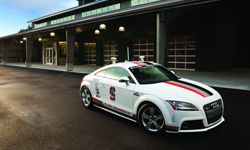GPS and other in-car displays are great for getting us from point A to point B, and some high-end vehicles even have displays on the windshield, but in the near future cars will be able to identify external objects in front of the driver and display information about them on the windshield.
Think of the Terminator, or many other science fiction stories, where a robot looks at a person or an object and automatically brings up information about them and can identify who or what they are. Augmented Reality dashboards, AR for short, will function in a similar way for drivers. BMW has already implemented a windshield display in some of their vehicles which displays basic information, but they're also developing augmented reality dashboards that will be able to identify objects in front a vehicle and tell the driver how far they are away from the object. The AR display will overlay information on top of what a driver is seeing in real life.
So if you're approaching a car too quickly, a red box may appear on the car you're approaching and arrows will appear showing you how to maneuver into the next lane before you collide with the other car. An augmented reality GPS system could highlight the actual lane you need to be in and show you where you need to turn down the road without you ever having to take your eyes off the road.
BMW is also researching the use of augmented reality for automotive technicians. They produced a video where a BMW technician uses AR glasses to look at an engine, identify what parts need to be replaced and then shows step-by-step instructions on how to fix it.
AR is also being researched for passengers as well. Toyota has produced working concepts of their AR system that would allow passengers to zoom in on objects outside of the car, select and identify objects, as well as view the distance of an object from the car using a touch-screen window.
Augmented reality may not be here yet, but if these car companies have their way, we'll be seeing it in our future cars a little ways down the road.
Go on to the next page to learn about a new use for an old technology.


